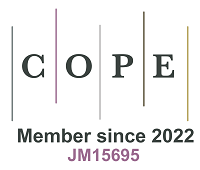REFERENCES
1. Figueiredo F, Lopes-Marques M, Almeida B, et al. A robust assay to monitor ataxin-3 amyloid fibril assembly. Cells 2022;11:1969.
2. Toulis V, Casaroli-Marano R, Camós-Carreras A, et al. Altered retinal structure and function in Spinocerebellar ataxia type 3. Neurobiol Dis 2022;170:105774.
3. do Carmo Costa M, Paulson HL. Toward understanding Machado-Joseph disease. Prog Neurobiol 2012;97:239-57.
4. Orr HT. Polyglutamine neurodegeneration: expanded glutamines enhance native functions. Curr Opin Genet Dev 2012;22:251-5.
5. Takiyama Y, Nishizawa M, Tanaka H, et al. The gene for Machado-Joseph disease maps to human chromosome 14q. Nat Genet 1993;4:300-4.
6. Matos CA, de Macedo-Ribeiro S, Carvalho AL. Polyglutamine diseases: the special case of ataxin-3 and Machado-Joseph disease. Prog Neurobiol 2011;95:26-48.
7. Margolis RL, Ross CA. Expansion explosion: new clues to the pathogenesis of repeat expansion neurodegenerative diseases. Trends Mol Med 2001;7:479-82.
8. Haas E, Incebacak RD, Hentrich T, et al. A novel SCA3 knock-in mouse model mimics the human SCA3 Disease phenotype including neuropathological, behavioral, and transcriptional abnormalities especially in oligodendrocytes. Mol Neurobiol 2022;59:495-522.
9. Paulson H, Shakkottai V. Spinocerebellar ataxia type 3. GeneReviews. 2020. Available from: https://www.ncbi.nlm.nih.gov/books/NBK1196/. [Last accessed on 6 Jun 2024].
10. Lima M, Costa MC, Montiel R, et al. Population genetics of wild-type CAG repeats in the Machado-Joseph disease gene in Portugal. Hum Hered 2005;60:156-63.
11. Ganev Y, Buhr TJ, Mahmood H. Manipulations of protective post-translational modifications of ataxin-3 as a possible treatment of SCA3. 2018. Available from: https://api.semanticscholar.org/CorpusID:195185159. [Last accessed on 6 Jun 2024].
12. Ricchelli F, Fusi P, Tortora P, et al. Destabilization of non-pathological variants of ataxin-3 by metal ions results in aggregation/fibrillogenesis. Int J Biochem Cell Biol 2007;39:966-77.
13. Marchal S, Shehi E, Harricane MC, et al. Structural instability and fibrillar aggregation of non-expanded human ataxin-3 revealed under high pressure and temperature. J Biol Chem 2003;278:31554-63.
14. Gales L, Cortes L, Almeida C, et al. Towards a structural understanding of the fibrillization pathway in Machado-Joseph’s disease: trapping early oligomers of non-expanded ataxin-3. J Mol Biol 2005;353:642-54.
15. Ellisdon AM, Thomas B, Bottomley SP. The two-stage pathway of ataxin-3 fibrillogenesis involves a polyglutamine-independent step. J Biol Chem 2006;281:16888-96.
16. Masino L, Nicastro G, De Simone A, Calder L, Molloy J, Pastore A. The Josephin domain determines the morphological and mechanical properties of ataxin-3 fibrils. Biophys J 2011;100:2033-42.
17. Conchillo-Solé O, de Groot NS, Avilés FX, Vendrell J, Daura X, Ventura S. AGGRESCAN: a server for the prediction and evaluation of “hot spots” of aggregation in polypeptides. BMC Bioinformatics 2007;8:65.
18. Fernandez-Escamilla AM, Rousseau F, Schymkowitz J, Serrano L. Prediction of sequence-dependent and mutational effects on the aggregation of peptides and proteins. Nat Biotechnol 2004;22:1302-6.
19. Maurer-Stroh S, Debulpaep M, Kuemmerer N, et al. Exploring the sequence determinants of amyloid structure using position-specific scoring matrices. Nat Methods 2010;7:237-42.
20. Trovato A, Seno F, Tosatto SC. The PASTA server for protein aggregation prediction. Protein Eng Des Sel 2007;20:521-3.
21. Tartaglia GG, Vendruscolo M. The Zyggregator method for predicting protein aggregation propensities. Chem Soc Rev 2008;37:1395-401.
22. Masino L, Nicastro G, Calder L, Vendruscolo M, Pastore A. Functional interactions as a survival strategy against abnormal aggregation. FASEB J 2011;25:45-54.
23. Scarff CA, Almeida B, Fraga J, Macedo-Ribeiro S, Radford SE, Ashcroft AE. Examination of ataxin-3 (atx-3) aggregation by structural mass spectrometry techniques: a rationale for expedited aggregation upon polyglutamine (polyQ) expansion. Mol Cell Proteomics 2015;14:1241-53.
24. Deriu MA, Grasso G, Licandro G, et al. Investigation of the Josephin Domain protein-protein interaction by molecular dynamics. PLoS One 2014;9:e108677.
25. Sawaya MR, Sambashivan S, Nelson R, et al. Atomic structures of amyloid cross-beta spines reveal varied steric zippers. Nature 2007;447:453-7.
26. Meng SR, Zhu YZ, Guo T, Liu XL, Chen J, Liang Y. Fibril-forming motifs are essential and sufficient for the fibrillization of human Tau. PLoS One 2012;7:e38903.
27. Thompson MJ, Sievers SA, Karanicolas J, Ivanova MI, Baker D, Eisenberg D. The 3D profile method for identifying fibril-forming segments of proteins. Proc Natl Acad Sci U S A 2006;103:4074-8.
28. Goldschmidt L, Teng PK, Riek R, Eisenberg D. Identifying the amylome, proteins capable of forming amyloid-like fibrils. Proc Natl Acad Sci U S A 2010;107:3487-92.
29. Ivanova MI, Sievers SA, Guenther EL, et al. Aggregation-triggering segments of SOD1 fibril formation support a common pathway for familial and sporadic ALS. Proc Natl Acad Sci U S A 2014;111:197-201.
30. Nelson R, Sawaya MR, Balbirnie M, et al. Structure of the cross-beta spine of amyloid-like fibrils. Nature 2005;435:773-8.
31. Kuhlman B, Baker D. Native protein sequences are close to optimal for their structures. Proc Natl Acad Sci U S A 2000;97:10383-8.
32. Toyama BH, Weissman JS. Amyloid structure: conformational diversity and consequences. Annu Rev Biochem 2011;80:557-85.
33. Kannan R, Raju M, Sharma KK. The critical role of the central hydrophobic core (residues 71-77) of amyloid-forming αA66-80 peptide in α-crystallin aggregation: a systematic proline replacement study. Amyloid 2014;21:103-9.
34. Chang HY, Lin JY, Lee HC, Wang HL, King CY. Strain-specific sequences required for yeast [PSI+] prion propagation. Proc Natl Acad Sci U S A 2008;105:13345-50.
35. Williams AD, Portelius E, Kheterpal I, et al. Mapping abeta amyloid fibril secondary structure using scanning proline mutagenesis. J Mol Biol 2004;335:833-42.
36. Tao H, Liu W, Simmons BN, Harris HK, Cox TC, Massiah MA. Purifying natively folded proteins from inclusion bodies using sarkosyl, Triton X-100, and CHAPS. Biotechniques 2010;48:61-4.
37. Fitzpatrick AWP, Falcon B, He S, et al. Cryo-EM structures of tau filaments from Alzheimer’s disease. Nature 2017;547:185-90.
38. Yang Y, Shi Y, Schweighauser M, et al. Structures of α-synuclein filaments from human brains with Lewy pathology. Nature 2022;610:791-5.
39. Hu JY, Zhang DL, Liu XL, et al. Pathological concentration of zinc dramatically accelerates abnormal aggregation of full-length human Tau and thereby significantly increases Tau toxicity in neuronal cells. Biochim Biophys Acta Mol Basis Dis 2017;1863:414-27.
40. Xu WC, Liang JZ, Li C, et al. Pathological hydrogen peroxide triggers the fibrillization of wild-type SOD1 via sulfenic acid modification of Cys-111. Cell Death Dis 2018;9:67.
41. Wang K, Liu JQ, Zhong T, et al. Phase separation and cytotoxicity of tau are modulated by protein disulfide isomerase and
42. Dai B, Zhong T, Chen ZX, et al. Myricetin slows liquid-liquid phase separation of Tau and activates ATG5-dependent autophagy to suppress Tau toxicity. J Biol Chem 2021;297:101222.
43. Teng PK, Eisenberg D. Short protein segments can drive a non-fibrillizing protein into the amyloid state. Protein Eng Des Sel 2009;22:531-6.
44. Robertson AL, Headey SJ, Saunders HM, et al. Small heat-shock proteins interact with a flanking domain to suppress polyglutamine aggregation. Proc Natl Acad Sci U S A 2010;107:10424-9.
45. Masino L, Nicastro G, Menon RP, Dal Piaz F, Calder L, Pastore A. Characterization of the structure and the amyloidogenic properties of the Josephin domain of the polyglutamine-containing protein ataxin-3. J Mol Biol 2004;344:1021-35.
46. Sicorello A, Różycki B, Konarev PV, Svergun DI, Pastore A. Capturing the conformational ensemble of the mixed folded polyglutamine protein ataxin-3. Structure 2021;29:70-81.e5.
47. Lupton CJ, Steer DL, Wintrode PL, Bottomley SP, Hughes VA, Ellisdon AM. Enhanced molecular mobility of ordinarily structured regions drives polyglutamine disease. J Biol Chem 2015;290:24190-200.
48. Nicastro G, Masino L, Esposito V, et al. Josephin domain of ataxin-3 contains two distinct ubiquitin-binding sites. Biopolymers 2009;91:1203-14.
49. Nicastro G, Menon RP, Masino L, Knowles PP, McDonald NQ, Pastore A. The solution structure of the Josephin domain of ataxin-3: structural determinants for molecular recognition. Proc Natl Acad Sci U S A 2005;102:10493-8.
50. Antony PMA, Mäntele S, Mollenkopf P, et al. Identification and functional dissection of localization signals within ataxin-3. Neurobiol Dis 2009;36:280-92.







